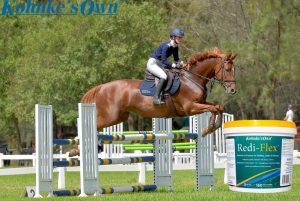Joint health is a common concern for horse owners. Joint related lameness problems are a significant career limiting factor for many performance horses, young horses in training as well as pleasure riding horses and ponies. Lameness accounts for up to 70 % of lost training days and competition outings, with osteoarthritis and joint disease being listed as the most frequent problem affecting performance.

Why do Joints Deteriorate?
The lower limb joints, including the knees and hocks, are subjected to high loading forces, compression and “wear and tear” during exercise. Poor limb conformation can exacerbate the risk of joint damage. Inadequate nutrition during the growing stage of a horse’s life can also be a trigger.
Joint deterioration begins progressively with compression and loading to the thin cartilage layer covering the bone, causing influx of inflammatory cells, damaging free radicals and destructive enzymes.
Joint cartilage has no blood or nerve supply and relies on joint fluid for its nutrition. It is often the first structure to degrade because of concussive thinning due to joint wear and tear, resulting in loss of its rebound properties and resilience. Once the highly sensitive bone layer underneath the cartilage is exposed, the horse will develop pain and lameness.
Overloading, concussion and repetitive joint stress are key risk factors that commonly affect joint health, function and mobility in performance and working horses.
The Effects of Inflammation on Joint Health
The main cause of joint cartilage damage is inflammation within the joint.
This inflammation in turn affects the quality, nutritional and lubricating function of synovial fluid which is present within the joint. Inflammatory enzymes act to erode the joint cartilage surface, triggering progressive deterioration of the entire internal joint area resulting in joint pain.
This can lead to loss of joint mobility, painful arthritic changes and lameness.
Nutrients such as organic sulfur (MSM), vitamin C and vitamin E are specific joint nutrients and antioxidant compounds that can naturally help ‘fight’ inflammation which is an underlying cause of joint deterioration and the progression to osteoarthritis.
Steps to Support Joint Health
As many horses are purchased during their mid years, proper nutrition is vital as the effects of a poor diet on joint health in early age may already be evident. Horses over the age of 10 which have been in regular training often will already be experiencing the effects of joint wear and tear or degradation. Older horses over the age of 15 may also develop arthritic changes even if they have only lightly worked.
The best supportive measures for joint health are focused on reducing inflammation and improving the nutritional quality of the joint fluid and cartilage health. An oral supplement containing glucosamine, a building block of healthy cartilage, helps to protect, repair and maintain healthy joints in horses.
Many joint supplements also include chrondroitin, however, this large and complex molecule is pooly absorbed during digestion and is not effective either alone or combined with glucosamine. In fact, Kohnkes’ Own double-blind studies on aging racehorses conclusively proved that, as found in human studies, chondroitin did not have any beneficial action in improving joint function or health.
There is an array of popular therapies to help support joint health. Joint supplements are often the first choice once a horse shows joint pain or stiffness, but these can be used in combination with joint injections, supportive shoeing and ice packing of the horse’s legs after work or competition for additional assistance, particularly in more severe cases affecting horses in moderate to heavy work.
Attention should also be given to the surface of the working area, with steps taken to minimise joint concussion from compacted or deep working surfaces.
How to Choose a Joint Supplement for Optimum Joint Health
Oral joint supplements can provide the nutritional building blocks for maintaining joint health. There are many equine joint supplements available today, although many only contain 1 or 2 active ingredients.
Kohnke’s Own® Redi-Flex® is a superior choice as it contains multiple joint active ingredients as a comprehensive joint food. Redi-Flex is formulated to include concentrated glucosamine, MSM, vitamin C, as well as vitamin E, selected trace-minerals, natural silicon compounds and other synergistic nutrients which are recognised to improve the health, development and resilience of cartilage and joint structures.
Redi-Flex® has numerous beneficial actions within the entire joint, as well as ligaments and tendons, to maintain joint health and function. Redi-Flex was trialled for over 2 years on more than 60 horses and has since become a popular and well recognised supplement with exceptional results in improving willingness of movement, flexibility and freedom of stride, as well as overall better joint health and function.
Redi-Flex® is suitable for all horses, including performance horses of all ages as well as aged and arthritic horses who benefit most from a joint supplement. Younger horses in training will also benefit from Redi-Flex as it provides essential nutrients to help maintain healthy joints and reduce the effects of joint concussion in high impact sports such as Racing, Polo, Polocrosse, Show-Jumping, Dressage, Western Sport and Eventing.
